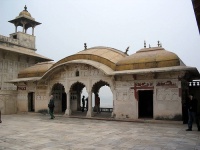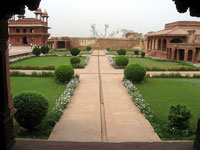
Not far from the gardens of the Taj Mahal stands the important 16th-century Mughal monument known as the Red Fort of Agra. This powerful fortress of red sandstone encompasses, within its 1.5 mile-long (2.5km) enclosure walls, the imperial city of the Mughal rulers. It comprises many fairytale palaces, such as the Jahangir Palace and the Khas Mahal, built by Shah Jahan; audience halls such as the Diwan-i-Khas; and the Sheesh Mahal (The Glass Palace), which is inlaid with thousands of mirrors and was once the harem dressing-room. There are also two beautiful mosques, including Shah Jahan's Pearl Mosque. The Octagonal Tower is exquisitely carved, and is the very place where Shah Jahan spent the last seven years of his life. The tower used to be known for providing one of the best views of the Taj Mahal - which is significant as Shah Jahan famously built the Taj as a memorial to his wife and no doubt enjoyed this view - but these days, regrettably, air pollution has reduced visibility.Not all of the areas and buildings in the Red Fort are open to visitors but there is plenty to see. Local guides are available at the entrance and hiring one is recommended because the fort has accumulated many great stories in its long history. Try to arrive early to avoid crowds and queues.
Address : Agra, Uttar Pradesh
Website : www.agrafort.gov.in/

The deserted city of Fatehpur Sikri was the capital of the Mughal Empire between 1570 and 1585. It was built under the personal supervision of the Emperor Akbar. The story goes that the emperor was childless and, having tried all sorts of solutions to his plight, visited a Sufi saint, Sheikh Salim Chishti, for help. Soon a son was born, and - impressed and overjoyed - Akbar started building on the site where he had met the saint. However, due to a severe shortage of water the city was abandoned after only fifteen years, and the capital was relocated back to Agra. As a result, Fatehpur Sikri stands untouched and perfectly preserved: a complete medieval fortress built of red sandstone, with vast central squares, exquisitely carved multi-tiered pavilions, cool terraces and formal gardens. It is best to hire a guide, or do some research before visiting, because the site is hugely enriched by some knowledge of its fascinating history and the many stories that have accumulated about the place. Visitors can walk freely around the vast complex admiring the intricate architecture and carvings and imagining how the royal family once lived. The gardens are also lovely and well-maintained.
Address : Fatehpur Sikri is a 25-mile (40km) journey west of Agra, on the way to Jaipur.
Website : www.fatehpursikri.gov.in/

The Taj Mahal is one of the world's most recognisable and evocative sights, and despite the incredible hype, a visit here cannot disappoint. Set overlooking the River Yamuna, visible from Agra Fort in the West, the Taj was built by Shah Jahan to enshrine the body of his favourite wife, who died giving birth to her 14th child, in 1631. The story of this great monument to love is given an added poignancy by the fate of Shah Jahan himself. When his devout and austere son Aurangzeb seized power, Shah Jahan was interned in Agra Fort, where he lived out his final years gazing wistfully at the Taj Mahal in the distance. When he died there, in January 1666, with his daughter Jahanara Begum at his side, his body was carried across the river to lie alongside his beloved wife in the peerless mausoleum.Completed in 1653, the Taj Mahal is set in a large walled garden, between two mini-Taj's (one of which is a mosque), and in front of a long reflecting pond. Close up, the craftsmanship of the building is as spectacular as from a distance - the inside of the vast double-dome is inlaid with delicately-filigreed verses from the Quran and semi-precious stones. Visitors should aim to visit it at dawn and at dusk, as the building truly does change colour through the day, from rosy pink, to gleaming ivory, to twilight-blue. Note that there can often be smog and fog in the mornings. Two days before and after the full moon, the Taj Mahal is open for moonlight viewing, but tickets must be booked at least 24 hours in advance, through the Archaeological Survey of India's offices in Agra.
Address : Dharmapuri, Forest Colony, Tajganj, Agra
Website : www.tajmahal.gov.in

Travel Guide powered by Word Travels, copyright © 2023 Globe Media Ltd. By its very nature information in this travel guide is subject to change at short notice and travellers are urged to verify information on which they're relying with the relevant authorities. Neither Globe Media Ltd nor Travel Vogue can accept any responsibility for any loss or inconvenience to any person as a result of information contained above.